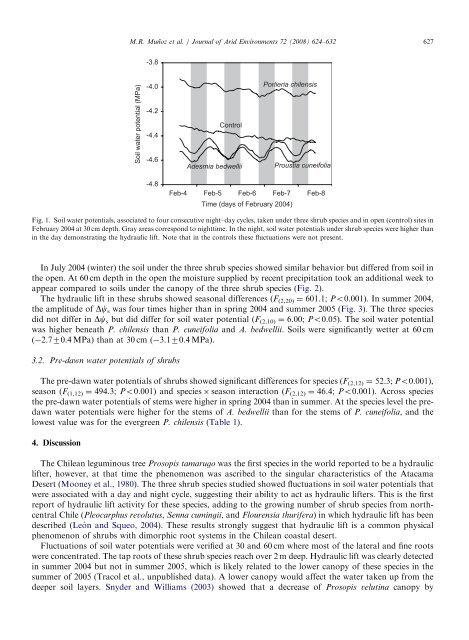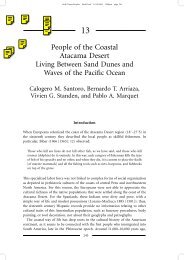Hydraulic lift in three shrub species from the Chilean coastal ... - IEB
Hydraulic lift in three shrub species from the Chilean coastal ... - IEB
Hydraulic lift in three shrub species from the Chilean coastal ... - IEB
Create successful ePaper yourself
Turn your PDF publications into a flip-book with our unique Google optimized e-Paper software.
ARTICLE IN PRESS<br />
M.R. Muñoz et al. / Journal of Arid Environments 72 (2008) 624–632 627<br />
-3.8<br />
Soil water potential (MPa)<br />
-4.0<br />
-4.2<br />
-4.4<br />
-4.6<br />
Control<br />
Adesmia bedwellii<br />
Porlieria chilensis<br />
Proustia cuneifolia<br />
-4.8<br />
Feb-4<br />
Feb-5 Feb-6 Feb-7<br />
Time (days of February 2004)<br />
Feb-8<br />
Fig. 1. Soil water potentials, associated to four consecutive night–day cycles, taken under <strong>three</strong> <strong>shrub</strong> <strong>species</strong> and <strong>in</strong> open (control) sites <strong>in</strong><br />
February 2004 at 30 cm depth. Gray areas correspond to nighttime. In <strong>the</strong> night, soil water potentials under <strong>shrub</strong> <strong>species</strong> were higher than<br />
<strong>in</strong> <strong>the</strong> day demonstrat<strong>in</strong>g <strong>the</strong> hydraulic <strong>lift</strong>. Note that <strong>in</strong> <strong>the</strong> controls <strong>the</strong>se fluctuations were not present.<br />
In July 2004 (w<strong>in</strong>ter) <strong>the</strong> soil under <strong>the</strong> <strong>three</strong> <strong>shrub</strong> <strong>species</strong> showed similar behavior but differed <strong>from</strong> soil <strong>in</strong><br />
<strong>the</strong> open. At 60 cm depth <strong>in</strong> <strong>the</strong> open <strong>the</strong> moisture supplied by recent precipitation took an additional week to<br />
appear compared to soils under <strong>the</strong> canopy of <strong>the</strong> <strong>three</strong> <strong>shrub</strong> <strong>species</strong> (Fig. 2).<br />
The hydraulic <strong>lift</strong> <strong>in</strong> <strong>the</strong>se <strong>shrub</strong>s showed seasonal differences (F (2,20) ¼ 601.1; Po0.001). In summer 2004,<br />
<strong>the</strong> amplitude of Dc s was four times higher than <strong>in</strong> spr<strong>in</strong>g 2004 and summer 2005 (Fig. 3). The <strong>three</strong> <strong>species</strong><br />
did not differ <strong>in</strong> Dc s but did differ for soil water potential (F (2,10) ¼ 6.00; Po0.05). The soil water potential<br />
was higher beneath P. chilensis than P. cuneifolia and A. bedwellii. Soils were significantly wetter at 60 cm<br />
( 2.770.4 MPa) than at 30 cm ( 3.170.4 MPa).<br />
3.2. Pre-dawn water potentials of <strong>shrub</strong>s<br />
The pre-dawn water potentials of <strong>shrub</strong>s showed significant differences for <strong>species</strong> (F (2,12) ¼ 52.3; Po0.001),<br />
season (F (1,12) ¼ 494.3; Po0.001) and <strong>species</strong> season <strong>in</strong>teraction (F (2,12) ¼ 46.4; Po0.001). Across <strong>species</strong><br />
<strong>the</strong> pre-dawn water potentials of stems were higher <strong>in</strong> spr<strong>in</strong>g 2004 than <strong>in</strong> summer. At <strong>the</strong> <strong>species</strong> level <strong>the</strong> predawn<br />
water potentials were higher for <strong>the</strong> stems of A. bedwellii than for <strong>the</strong> stems of P. cuneifolia, and <strong>the</strong><br />
lowest value was for <strong>the</strong> evergreen P. chilensis (Table 1).<br />
4. Discussion<br />
The <strong>Chilean</strong> legum<strong>in</strong>ous tree Prosopis tamarugo was <strong>the</strong> first <strong>species</strong> <strong>in</strong> <strong>the</strong> world reported to be a hydraulic<br />
<strong>lift</strong>er, however, at that time <strong>the</strong> phenomenon was ascribed to <strong>the</strong> s<strong>in</strong>gular characteristics of <strong>the</strong> Atacama<br />
Desert (Mooney et al., 1980). The <strong>three</strong> <strong>shrub</strong> <strong>species</strong> studied showed fluctuations <strong>in</strong> soil water potentials that<br />
were associated with a day and night cycle, suggest<strong>in</strong>g <strong>the</strong>ir ability to act as hydraulic <strong>lift</strong>ers. This is <strong>the</strong> first<br />
report of hydraulic <strong>lift</strong> activity for <strong>the</strong>se <strong>species</strong>, add<strong>in</strong>g to <strong>the</strong> grow<strong>in</strong>g number of <strong>shrub</strong> <strong>species</strong> <strong>from</strong> northcentral<br />
Chile (Pleocarphus revolutus, Senna cum<strong>in</strong>gii, and Flourensia thurifera) <strong>in</strong> which hydraulic <strong>lift</strong> has been<br />
described (Leo´n and Squeo, 2004). These results strongly suggest that hydraulic <strong>lift</strong> is a common physical<br />
phenomenon of <strong>shrub</strong>s with dimorphic root systems <strong>in</strong> <strong>the</strong> <strong>Chilean</strong> <strong>coastal</strong> desert.<br />
Fluctuations of soil water potentials were verified at 30 and 60 cm where most of <strong>the</strong> lateral and f<strong>in</strong>e roots<br />
were concentrated. The tap roots of <strong>the</strong>se <strong>shrub</strong> <strong>species</strong> reach over 2 m deep. <strong>Hydraulic</strong> <strong>lift</strong> was clearly detected<br />
<strong>in</strong> summer 2004 but not <strong>in</strong> summer 2005, which is likely related to <strong>the</strong> lower canopy of <strong>the</strong>se <strong>species</strong> <strong>in</strong> <strong>the</strong><br />
summer of 2005 (Tracol et al., unpublished data). A lower canopy would affect <strong>the</strong> water taken up <strong>from</strong> <strong>the</strong><br />
deeper soil layers. Snyder and Williams (2003) showed that a decrease of Prosopis velut<strong>in</strong>a canopy by

















